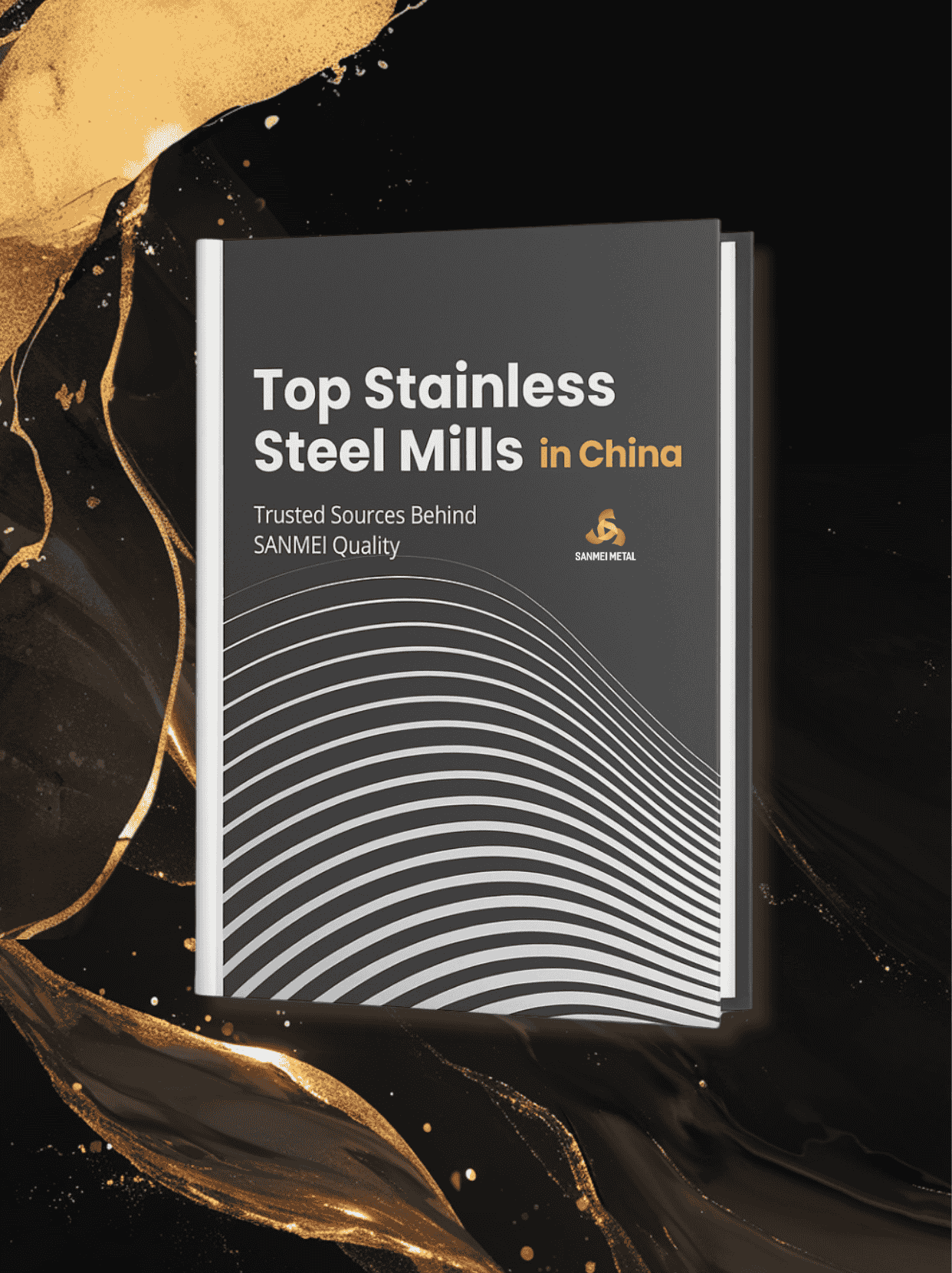
Obtén tu GRATIS Acceso: Expediente de la planta siderúrgica #1 de China
Orientado al comprador: Buscar molinos que se ajusten a las necesidades del cliente según el grado, el acabado, el ancho, el espesor y la aplicación.
BAOUWUTsingshanLiscoTisco


441 es equivalente a
Resistencia a la corrosión del acero inoxidable 441
Buena resistencia a la corrosión en ambientes suaves, mejor que 409 y 430.
Resistencia al calor del acero inoxidable 441
Buena resistencia a la oxidación hasta 900°C.
Maquinabilidad del acero inoxidable 441
Similar al acero inoxidable 430. Maquinabilidad moderada.
Soldadura de acero inoxidable 441
Buena soldabilidad con todos los métodos habituales. No requiere tratamiento térmico posterior a la soldadura.
Trabajo en caliente de acero inoxidable 441
Calentar a una temperatura de 816 °C a 1038 °C (1500 °F a 1900 °F). No trabajar a menos de 1500 °F.
Recocido de acero inoxidable 441
Recocido a 815°C – 845°C seguido de enfriamiento por aire.
Trabajo en frío de acero inoxidable 441
Mejor formabilidad que el 430, comparable al 304.
Endurecimiento del acero inoxidable 441
No se puede endurecer mediante tratamiento térmico, sólo mediante trabajo en frío.
Aplicación del acero inoxidable 441
Sistemas de escape de automóviles, intercambiadores de calor y utensilios de cocina.
| Propiedades mecánicas del acero inoxidable 441 | ||||
| Propiedad | Resistencia a la fluencia, mín. (ksi) | Resistencia a la tracción, mín. (ksi) | Alargamiento, mín. (%) | Dureza, máx. (Rb) |
| Valor | 30 | 60 | 20 | 89 |
| Propiedades físicas del acero inoxidable 441 | ||
| Propiedad | Valor | Unidad |
| Densidad | 0.277 | libra/pulgada³ |
| Módulo de elasticidad | 29,0 x 10^6 | psi |
| Coeficiente de expansión térmica (68-212 °F) | 9,2 x 10^-6 | /°F |
| Conductividad térmica | 16 | BTU/pie·hora·°F |
| Calor específico | 0.11 | BTU/lb·°F |
| Resistividad eléctrica | 24 | Entrada de microohmios |
| Calificación | C (máx.) | Mn (máximo) | Si (Máx.) | P (máx.) | S (máximo) | Cr (máximo) | Ti (máximo) | Nb (máximo) | Fe (máx.) |
| 441 | 0.03 | 1 | 1 | 0.04 | 0.015 | 17.5 - 18.5 | 0.10 - 0.60 | 0.3+3 - 1.00 | Balance |
SS 441:Acero inoxidable ferrítico con aproximadamente cromo 18%, bajo contenido de carbono y titanio agregado para estabilización.
SS 304:Acero inoxidable austenítico con aproximadamente 18% de cromo y 8% de níquel.
SS 441:Estructura ferrítica (magnética).
SS 304:Estructura austenítica (no magnética).
SS 441:Buena resistencia a la corrosión, especialmente en ambientes que contienen cloruros y ácidos orgánicos.
SS 304:Excelente resistencia a la corrosión en una amplia gama de entornos, incluidos aquellos que contienen soluciones ácidas y de cloruro.
SS 441:Menor resistencia y ductilidad en comparación con el 304, pero buena resistencia al agrietamiento por corrosión bajo tensión.
SS 304:Mayor resistencia y ductilidad; más conformable y soldable.
SS 441:Se utiliza en sistemas de escape de automóviles, intercambiadores de calor y utensilios de cocina.
SS 304:Ampliamente utilizado en equipos de cocina, equipos de procesamiento químico y aplicaciones arquitectónicas.
SS 304:Mantiene la resistencia a temperaturas más altas y tiene mejor resistencia al calor.
SS 441:Adecuado para temperaturas moderadas, pero generalmente no tan resistente al calor como el 304.
SS 304:Mejor resistencia general a la corrosión, particularmente en ambientes ácidos y con cloruros.
SS 441:Buena resistencia a la corrosión, pero puede ser más propenso a la corrosión en ciertos entornos en comparación con el 304.
SS 304:Más duradero debido a su mayor resistencia y ductilidad.
SS 441:Durabilidad adecuada para muchas aplicaciones de escape, a menudo preferido por su rentabilidad.
SS 441:Contiene aproximadamente cromo 18%, con titanio agregado para estabilización.
SS 316:Contiene aproximadamente 16% de cromo, 10% de níquel y 2% de molibdeno.
SS 441:Buena resistencia a la corrosión, especialmente en ambientes que contienen cloruros y ácidos orgánicos.
SS 316:Resistencia superior a la corrosión, especialmente contra cloruros y ambientes marinos debido a la presencia de molibdeno.
SS 441:Se utiliza en sistemas de escape de automóviles, intercambiadores de calor y utensilios de cocina.
SS 316:Se utiliza en aplicaciones marinas, procesamiento químico y dispositivos médicos.
SS 441: Generalmente más rentable.
SS 316:Más caro debido al mayor contenido de aleación.
SS 441:Contiene aproximadamente cromo 18%, con titanio agregado para estabilización.
SS 409:Contiene aproximadamente cromo 11%, con titanio agregado para estabilización.
SS 441:Mejor resistencia a la corrosión debido al mayor contenido de cromo.
SS 409:Menor resistencia a la corrosión en comparación con el 441, adecuado para entornos suaves.
SS 441:Se utiliza en sistemas de escape de automóviles, intercambiadores de calor y utensilios de cocina más exigentes.
SS 409:Se utiliza comúnmente en sistemas de escape de automóviles donde el costo y la resistencia moderada a la corrosión son importantes.
SS 441:Mejor formabilidad y mayor resistencia a la temperatura.
SS 409:Adecuado para muchas aplicaciones de escape, pero menos moldeable y resistente al calor en comparación con el 441.

| Tipo | Ancho (mm) | Peso (MT) | Espesor (mm) | ||||
| Bobina 441 | 1000, 1219, 1240, 1500 o personalizado | 3-10 | 0.15-3.0 | ||||

| Tipo | Ancho (mm) | Longitud (mm) | Espesor (mm) | |||||||||
| 441 hojas | 1000, 1219, 1240, 1500 o personalizado | 2000, 2438, 2500, 3000, 3048 | 0.3-3.0 | |||||||||
Nos comprometemos a brindar a nuestros clientes el mejor servicio y de la más alta calidad para garantizar su satisfacción.









Certificados por prestigiosas instituciones y comprometidos a adherirnos a los estándares internacionales en todos los aspectos.




La opinión de los clientes es el reflejo más auténtico de la calidad de una empresa.
Ver más referencias técnicas de Sanmei Metal sobre bobinas de acero inoxidable y chapas de acero inoxidable.
Sede:
Centro de Creación, n.º 142, calle Yuhe, pueblo de Lecong, distrito de Shunde, ciudad de Foshan, provincia de Guangdong, China. 528315
Fábrica: Ciudad Logística de Liyuan, Pueblo de Chencun, Distrito de Shunde, Ciudad de Foshan, Provincia de Guangdong, China. 528313
Base de apoyo local de Australia: (Yatala, QLD) – Próximamente en 2026